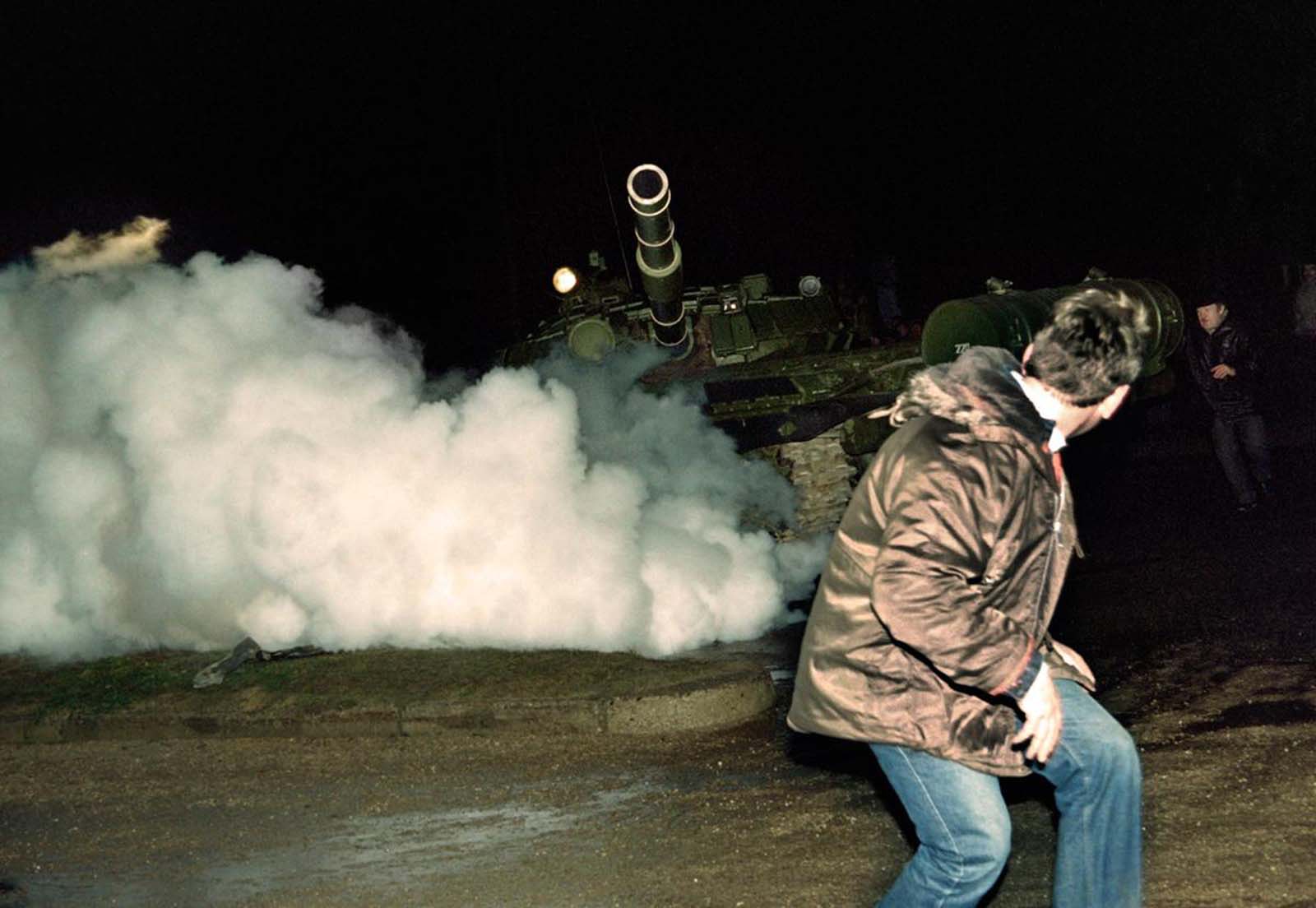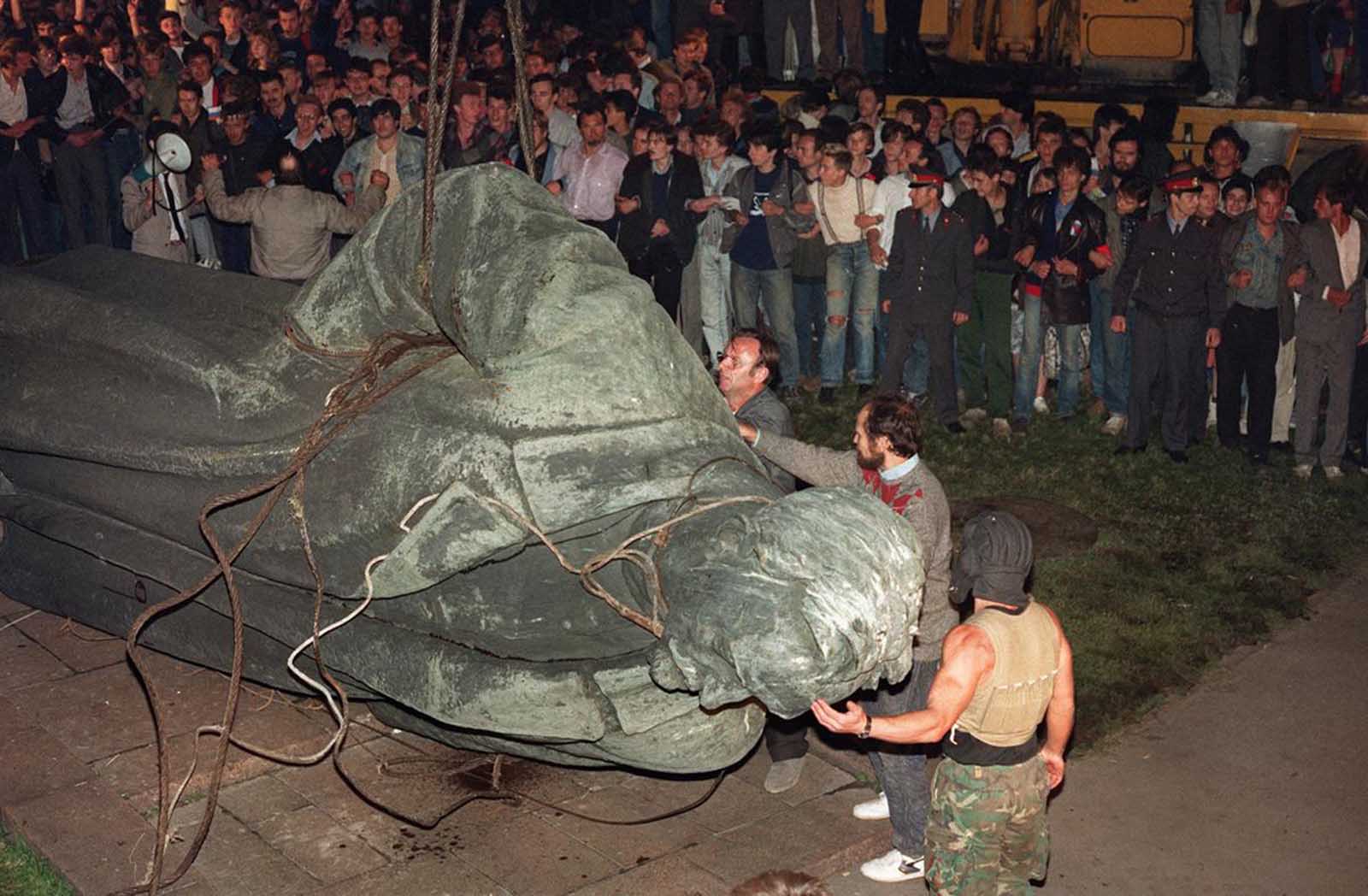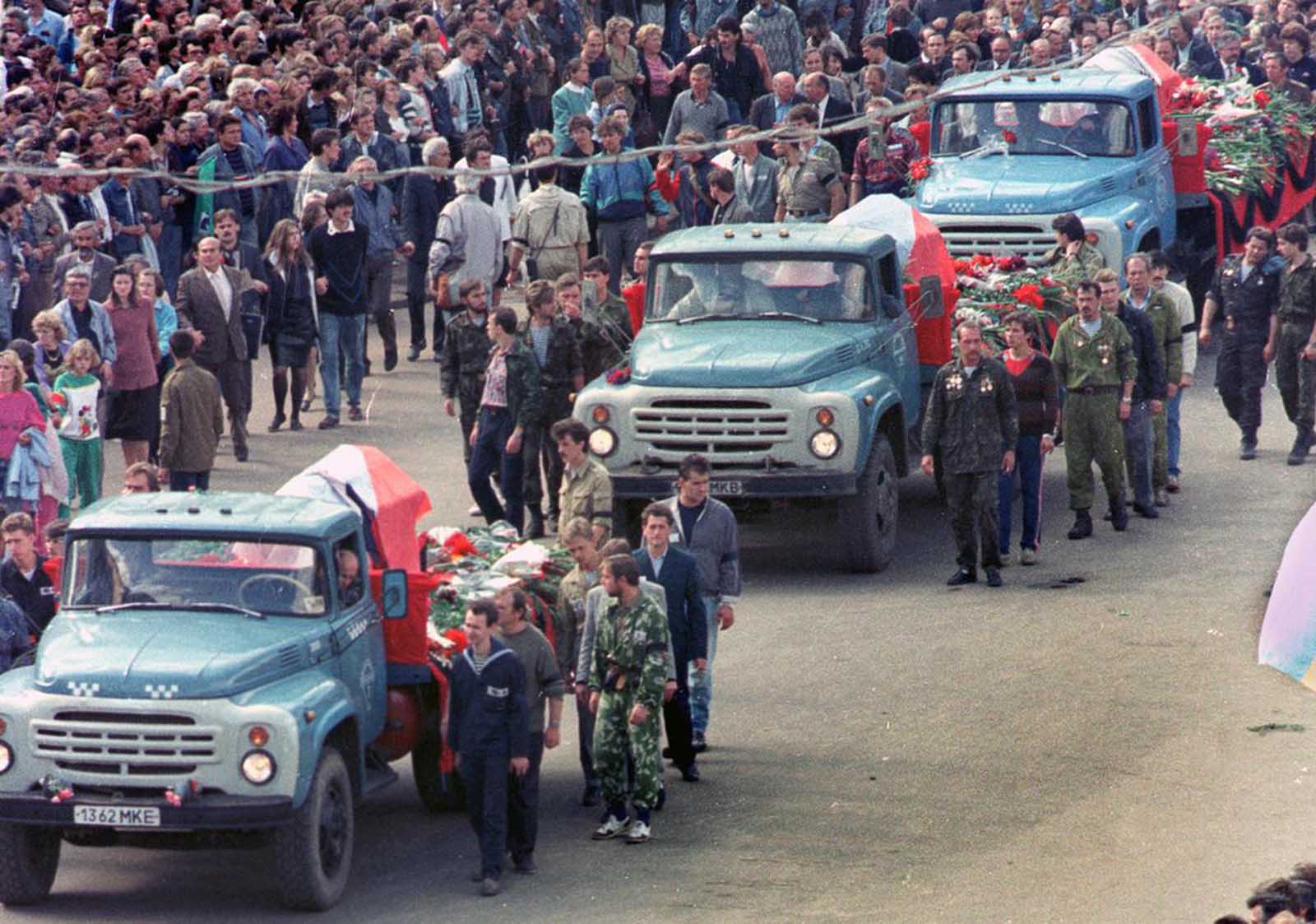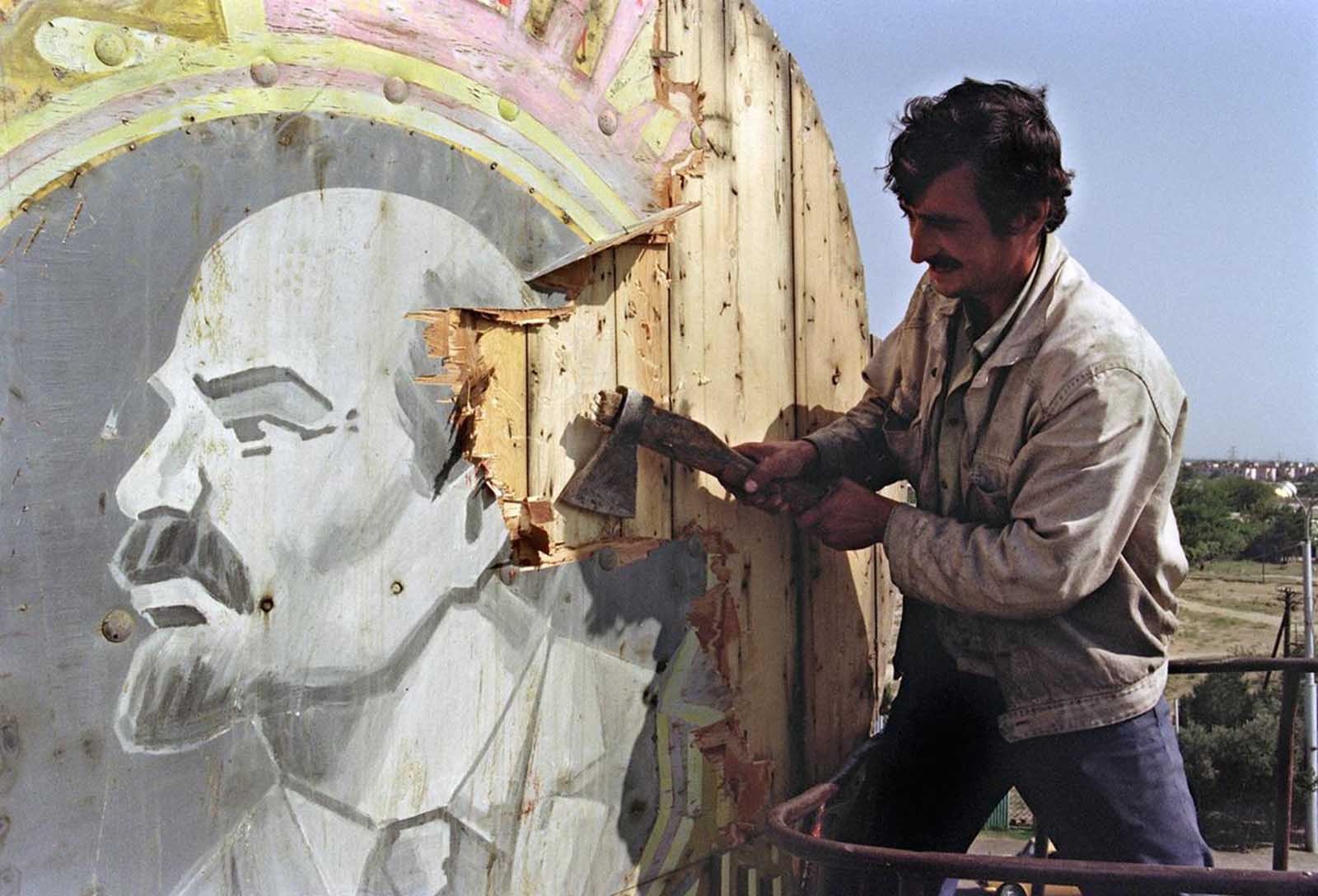
A woman reaches into her bag, which rests on a fallen Soviet hammer-and-sickle on a Moscow street in 1991.
In December of 1991, as the world watched in amazement, the Soviet Union disintegrated into fifteen separate countries.
Its collapse was hailed by the west as a victory for freedom, a triumph of democracy over totalitarianism, and evidence of the superiority of capitalism over socialism.
The United States rejoiced as its formidable enemy was brought to its knees, thereby ending the Cold War which had hovered over these two superpowers since the end of World War II.
Indeed, the breakup of the Soviet Union transformed the entire world’s political situation, leading to a complete reformulation of political, economic, and military alliances all over the globe.

Lithuanians carry Lithuanian flags in the center of Vilnius on January 10, 1990, during demonstration asking for the country’s independence. In early 1990, Sajudis-Reform Movement of Lithuania backed candidates won the elections to the Lithuanian Supreme Soviet. On March 11, 1990, the Supreme Soviet proclaimed the re-establishment of Lithuanian independence. The Baltic republics were in forefront of the struggle for independence and Lithuania was the first of the Soviet republics to declare independence.
What led to this monumental historical event? In fact, the answer is a very complex one, and can only be arrived at with an understanding of the peculiar composition and history of the Soviet Union.
The Soviet Union was built on approximately the same territory as the Russian Empire which it succeeded.
After the Bolshevik Revolution of 1917, the newly-formed government developed a philosophy of socialism with the eventual and gradual transition to Communism.
The state which the Bolsheviks created was intended to overcome national differences, and rather to create one monolithic state based on a centralized economical and political system.
This state, which was built on a Communist ideology, was eventually transformed into a totalitarian state, in which the Communist leadership had complete control over the country.

People buy teacups in the Vilnius downtown shop on Friday, April 27, 1990. Despite an economic blockade of Lithuania by Soviet forces, shops in Vilnius are well supplied with food and other goods as Lithuania entered the 10th day of a blockade.
However, this project of creating a unified, centralized socialist state proved problematic for several reasons.
First, the Soviets underestimated the degree to which the non-Russian ethnic groups in the country (which comprised more than fifty percent of the total population of the Soviet Union) would resist assimilation into a Russianized State.
Second, their economic planning failed to meet the needs of the State, which was caught up in a vicious arms race with the United States. This led to gradual economic decline, eventually necessitating the need for reform.
Finally, the ideology of Communism, which the Soviet Government worked to instill in the hearts and minds of its population, never took firm root, and eventually lost whatever influence it had originally carried.

Soviet President Mikhail Gorbachev, center, in animated conversation with residents of Vilnius, Lithuania, on Thursday, January 11, 1990. Gorbachev was in the Lithuanian capital to press for reversal of the local communist party’s decision to split from Moscow and to slow the republic’s drive for complete independence.
By the time of the 1985 rise to power of Mikhail Gorbachev, the Soviet Union’s last leader, the country was in a situation of severe stagnation, with deep economic and political problems which sorely needed to be addressed and overcome. Recognizing this, Gorbachev introduced a two-tiered policy of reform.
On one level, he initiated a policy of glasnost, or freedom of speech. On the other level, he began a program of economic reform known as perestroika, or rebuilding.
What Gorbachev did not realize was that by giving people complete freedom of expression, he was unwittingly unleashing emotions and political feelings that had been pent up for decades, and which proved to be extremely powerful when brought out into the open.

A crowd blocks the passage of Soviet tanks on a road near Ganja, formerly Kirovabad, in Soviet Azerbaijan, on January 22, 1990. Troops sent into the area last week to quell ethnic violence met both armed and peaceful resistance.
Moreover, his policy of economic reform did not have the immediate results he had hoped for and had publicly predicted.
The Soviet people consequently used their newly allotted freedom of speech to criticize Gorbachev for his failure to improve the economy.
The disintegration of the Soviet Union began on the peripheries, in the non-Russian areas.
The first region to produce mass, organized dissent was the Baltic region, where, in 1987, the government of Estonia demanded autonomy.
This move was later followed by similar moves in Lithuania and Latvia, the other two Baltic republics.

Residents face a cordon of Soviet Interior Ministry troops in front of the local Communist Party Headquarters in the Tajikistan capital of Dushanbe, on February 15, 1990. Soviet authorities declared a state of emergency in the city, following ethnic rioting.
The nationalist movements in the Baltics constituted a strong challenge to Gorbachev’s policy of glasnost.
He did not want to crack down too severely on the participants in these movements, yet at the same time, it became increasingly evident that allowing them to run their course would spell disaster for the Soviet Union, which would completely collapse if all of the periphery republics were to demand independence.
After the initiative from Estonia, similar movements sprang up all over the former Soviet Union.
In the Transcaucasus region (in the South of the Soviet Union), a movement developed inside the Armenian-populated autonomous region of Nagorno-Karabagh, in the Republic of Azerbaijan.

Two Soviet paratroopers inspect weapons confiscated from a local militia organization in Kaunas, Lithuania on Sunday, March 26, 1990. Soviet President Gorbachev ordered all Lithuanians to surrender their firearms to Soviet authorities.
The Armenian population of this region demanded that they be granted the right to secede and join the Republic of Armenia, with whose population they were ethnically linked.
Massive demonstrations were held in Armenia in solidarity with the secessionists in Nagorno-Karabagh.
The Gorbachev government refused to allow the population of Nagorno-Karabagh to secede, and the situation developed into a violent territorial dispute, eventually degenerating into an all-out war that continues unabated until the present day.

Soviet mothers who lost their sons in the Red Army are held back by State militia as they hold photographs of their loved ones in Red Square, on Monday, December 24, 1990. A group of about 200 Soviet parents who have all lost sons through ethnic violence and accidents within the Soviet armed services demonstrated outside the Kremlin. 6,000 Soviet service men were killed during 1990.
Once this “Pandora’s box” had been opened, nationalist movements emerged in Georgia, Ukraine, Moldova, Byelorussia, and the Central Asian republics.
The power of the Central Government was considerably weakened by these movements; they could no longer rely on the cooperation of Government figures in the republics.
Finally, the situation came to a head in August of 1991.
In a last-ditch effort to save the Soviet Union, which was floundering under the impact of the political movements which had emerged since the implementation of Gorbachev’s glasnost, a group of “hard-line” Communists organized a coup d’etat.

About 100,000 demonstrators march on the Kremlin in Moscow on January 20, 1991. Many called for the resignation of Soviet President Mikhail Gorbachev protesting against the Soviet army crackdown against the nationalist Lithuanian authorities. Lithuania had been the first Baltic Republic to proclaim its independence in March 1990.
They kidnapped Gorbachev, and then, on August 19 of 1991, they announced on state television that Gorbachev was very ill and would no longer be able to govern.
The country went into an uproar. Massive protests were staged in Moscow, Leningrad, and many of the other major cities of the Soviet Union.
When the coup organizers tried to bring in the military to quell the protestors, the soldiers themselves rebelled, saying that they could not fire on their fellow countrymen.

Soviet soldiers patrol an emptied Red Square in Moscow, on March 27, 1991, after the area had been blocked off in anticipation of a pro-Yeltsin rally.
After three days of massive protest, the coup organizers surrendered, realizing that without the cooperation of the military, they did not have the power to overcome the power of the entire population of the country.
After the failed coup attempt, it was only a few months until the Soviet Union completely collapsed.
Both the government and the people realized that there was no way to turn back the clock; the massive demonstrations of the “August days” had demonstrated that the population would accept nothing less than democracy.
Gorbachev conceded power, realizing that he could no longer contain the power of the population.
On December 25, 1991, he resigned. By January of 1992, by popular demand, the Soviet Union ceased to exist. Collected here are photos from those tumultuous months.

Anti-Soviet political graffiti filled an entire wall in Vilnius on January 17, 1991. The wall surrounding the Lithuanian parliament was erected to defend against a possible raid by Soviet troops. Many Soviet army deserters pinned their draft cards to a defaced poster of President Mikhail Gorbachev.

In this photo taken on January 13, 1991, a Lithuanian demonstrator runs in front of a Soviet Red Army tank during an assault on the Lithuanian Radio and Television station in Vilnius. Soviet troops opened fire on unarmed civilians in Vilnius, killing 13 people and injuring 100 others.

An armed Lithuanian volunteer guard wakes up as his fellow compatriot slept in Vilnius, Lithuania, on January 23, 1991. Hundreds of gunmen held vigil in the heavily fortified Lithuanian parliament while Soviet President Mikhail Gorbachev urged all Baltic republics to prevent further violence.

Pall-bearers carry a flag-draped casket during a funeral procession through Vilnius, on January 16, 1991, for 10 of the 13 people killed when Soviet troops stormed the Lithuanian broadcast center the previous weekend. Hundreds of thousands of Lithuanians jammed the procession route to mourn their national heroes.

A few weeks before the Coup, Mikhail Gorbachev stands surrounded by his so-called friends, all of them soon to be leaders of the August Coup against him. Vice President Gennady Yanayev, second from right, became the most visible of the Coup leaders. Here, they are lighting the flame at the tomb of the unknown soldier outside the Kremlin wall in May of 1991.

Soviet Army tanks parked near Spassky Gate, an entrance to the Kremlin and Basil’s Cathedral in Moscow’s Red Square after a coup toppled Soviet President Mikhail Gorbachev on August 19, 1991. Tanks rolled through Moscow towards the Russian White House, where Boris Yeltsin, leader of the Soviet-era Russian republic at the time, gathered his supporters after denouncing the coup.

The leaders of the August Coup: from left, Soviet Interior Minister Boris Pugo, Soviet Vice President Gennady Yanayev, and Oleg Baklanov, the first Vice-President of the Soviet Defence Council. These men were members of the self-styled “committee for the state of emergency” which headed the coup against Soviet President Mikhail Gorbachev. Here, they gave a press conference on August 19, 1991 in Moscow.

A crowd gathers around a personnel carrier as some people climb aboard the vehicle and try to block its advance near Red Square in downtown Moscow, on August 19, 1991. Military vehicles were on the streets of Moscow following the announcement that Soviet President Mikhail Gorbachev was replaced by Gennady I. Yanayev in a coup attempt by hard-line Communists.

Supporters of Russian president Yeltsin roll a large metal pipe to use as a barricade near the Russian federation building in Moscow, on August 19, 1991, following a military coup attempt by Soviet hardliners.

Russian President Boris Yeltsin (left) stands on top of an armored vehicle parked in front of the Russian Federation building as supporters hold a Russian federation flag on August 19, 1991, during a coup attempt. Yeltsin addressed a crowd of supporters calling for a general strike.

A picture shows Soviet President Mikhail Gorbachev speaking in a video message taped on August 19, 1991, the second day of his captivity. Gorbachev said there had been an unconstitutional coup and that he was completely well. Photo taken on August 25, 1991.

A pro-democracy demonstrator fights with a Soviet soldier on top of a tank parked in front of the Russian Federation building on August 19, 1991, after a coup toppled Soviet President Mikhail Gorbachev. The same day, thousands in Moscow, Leningrad, and other cities answered Russian Republic President Boris Yeltsin’s call to raise barricades against tanks and troops.

A defiant Russian President Boris Yeltsin (left) raises a fist to his supporters from the Russian Federation building in Moscow on August 19, 1991, calling on them to hold a general strike and to resist the pro-communist coup against Soviet President Gorbachev.

Over 50,000 people ignore a declared state of emergency and gather in front of the Russian parliament building in order to support Boris Yeltsin, on August 20, 1991.

A pro-democracy demonstrator argues with a Soviet soldier late on August 20, 1991, as a tank blocked access to the center of Moscow.

Residents play music and talk to soldiers in front of the Russian White House in central Moscow early on August 20, 1991.

People stand on a barricade in front the Russian White House in Moscow on August 21, 1991.

A soldier waves a Russian flag from the top of his tank as armored units leave their positions in Moscow following the collapse of the military coup against president Gorbachev on August 21, 1991. Coup leaders fled the capital and president Gorbachev was rumored to be returning soon.

Part of a large crowd, outside the Russian Parliament building in Moscow, celebrates the news that the hardline Communist coup has failed, on August 22, 1991.

Celebrations in Moscow after the failure of the coup attempt, and remembrances of those killed in the violence, in August of 1991.

A crowd watches the statue of KGB founder Dzerzhinsky being toppled in Lubyanskaya Square in Moscow, on August 22, 1991.

President Mikhail Gorbachev, in the Soviet Parliament right after his return from being under house arrest during the August, 1991 coup.

People follow a funeral procession for the victims of the coup in front of Russian White House in Moscow on August 24, 1991, after the coup attempt failed.

A group of Boris Yeltsin supporters rip apart one of the barricades surrounding the Russian federation building in Moscow, on August 25, 1991, following a coup attempt a few days before that eventually failed.

A Baku resident uses an axe to hack apart a placard showing a portrait of Russian Bolshevik revolutionary leader Vladimir Lenin, on September 21, 1991. Azerbaijan was proclaimed a Soviet Socialist Republic by Soviet Union in 1920. The Azeri National Council voted for its declaration of independence in 1991.

A member of the KGB (right) who requested anonymity hands over his weapon to a Lithuanian official before leaving the KGB headquarters in Vilnius after Lithuanian government decided to drop the Soviet secret service organization, on August 31, 1991.

Soviet rock fans attend a concert in Moscow on September 28, 1991. Half a million people jammed an airfield to see the Monsters of Rock concert featuring AC/DC, Pantera and Metallica at the Soviet Union’s biggest Western rock concert, touted as a gift to Russian youth for their resistance to last month’s coup.

A young Lithuanian girl sits on the toppled statue of Russian Bolshevik revolutionary leader Vladimir Lenin in Vilnius after the monument was removed from the center of the Lithuanian capital, on September 1, 1991.

A jubilant Chechen secessionist with clenched fists opens his arms to the crowd during a rally in Grozny, on November 14, 1991, to celebrate the pullout of Soviet troops from the Muslim enclave in Southern Russia.

Citizens of the Ukraine vote on a referendum for independence from the Soviet Union at the Ukraine Embassy in Moscow, on December 1, 1991.

The Musichick family watches Soviet President Mikhail Gorbachev’s resignation speech on Soviet television in their downtown Moscow apartment, on December 25, 1991. Gorbachev, whose reforms gave Soviet citizens freedom but ultimately led to the destruction of his nation resigned on as President of a Communist empire that no longer exists.

For one of the last times, the Soviet flag flies over the Kremlin at Red Square in Moscow, on Saturday night, December 21, 1991. The flag was replaced by the Russian flag on New Year’s.
(Photo credit: AFP / AP Photos / Museum of Cold War).
Updated on: August 20, 2024
Any factual error or typo? Let us know.



